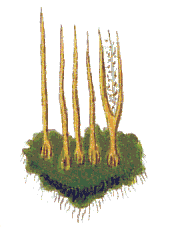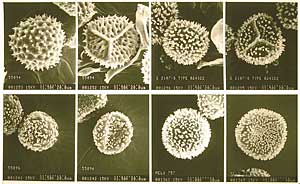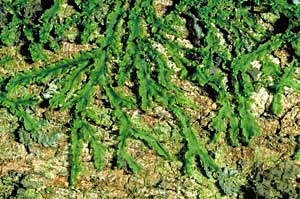
Classification and identification
Hornworts (phylum Anthocerotophyta)
The starting point is the group of four hornwort classification schemes set out in the paper given in the next Reference button. They are based primarily on morphology (macroscopic and microscopic) and cellular structure and, for the sake of brevity, will be referred to collectively as the 2000 classification on this web page. They provide a good framework on which to build a short account of the problems and principles of hornwort classification and against which to contrast some findings from later studies![]() .
.
Those schemes were proposed by four different, and very competent, bryologists between 1988 and 1994 and the following table summarizes the schemes. After that there will be a discussion about some of the features of these schemes as well as something about more recent hornwort research. Current thinking holds that there are about 150 hornwort species in the world, dramatically fewer than either liverwort or moss species numbers. Given the small number of species and the somewhat chaotic state of hornwort classification, there'll be no estimates of species per order for the various classification schemes.
class: AnthocerotopsidaClassification 1 order: Anthocerotales (2 families, 4 genera) order: Foliocerotales (1 family, 1 genus) order: Leiosporocerotales (1 family, 1 genus) order: Dendrocerotales (1 family, 1 genus) Classification 2 order: Anthocerotales (1 family, 5 genera) Classification 3 order: Anthocerotales (2 families, 8 genera) order: Notothylales (1 family, 1 genus) Classification 4 order: Anthocerotales (2 families, 8 genera)
|
The proposers of the four classifications did at least agree on having just one class for the hornworts, but clearly disagreed on all lower taxonomic ranks. Note that while the proposers of schemes 2 and 4 agreed on having just one order for the hornworts, they disagreed about families and genera. It is worthwhile noting that in earlier classification schemes up to 12 genera had been proposed for the hornworts.
These classification schemes have made use of both macroscopic and microscopic features, such as spore ornamentation. The eight photos in the accompanying composite image show spores from four different hornwort species, a pair of images for each species. The two photos in each pair show different spore faces. The spores in the upper row are from the genus Anthoceros. The pair of photos on the left are of a species different to that shown by the pair of photos on the right. On the lower line, the left hand pair shows spores of a species of the genus Folioceros and the right hand pair shows spores of a species of the genus Sphaerosporoceros.
The fact that there was plausible evidence to support four different classification schemes indicates problems with the features that had been used for hornwort classification. There are various reasons for that. The thalli can at times show considerable plasticity, leading to the discovery of growth forms that are intermediate between already defined species. That of course throws doubt on the boundaries between species and also led to greater reliance on stable microscopic features. Much more still needs to be done on aspects such as the micro-morphology, cellular structure and the development of gametophytes and sporophytes. While there has been solid work in those areas, there are still significant, unanswered questions. Molecular studies have helped elucidate relationships in other groups of organisms where there is plasticity of form or insufficient knowledge of their biology or developmental detail. However, there has been very limited research using hornwort genomes, typically with very few species in such studies. Since 2003 there has been a considerable increase in such studies, but the hornworts are still well behind the mosses and liverworts in this area of research.
The authors of the 2007 paper given in the next reference button would divide the hornworts into two classes and five orders, with the breakdown given in the following table.
class: Leiosporocerotopsidaorder: Leiosporocerotales (1 family, 1 genus) class: Anthocerotopsidaorder: Anthocerotales (1 family, 3 genera) order: Notophyladales (1 family, 4 genera) order: Phymatocerales (1 family, 1 genus) order: Dendrocerotales (1 family, 4 genera)
|
The authors consider the genus Leiosporoceros (with its one species Leiosporoceros dussii) to differ enough from the other hornworts to warrant a class of its own. In this classification 13 genera are split into five orders but the authors stated that the placement of four of those thirteen genera is tentative, given the lack of critical information about those four. More molecular work as well as additional non-molecular studies are needed to test the robustness of this classification scheme.
Amongst all these different classification schemes it's not surprising that some hornworts have been shuffled around. For example, some have considered the genus Phaeoceros to be closely related to the genus Notothylas, with the two placed in the same family, while others have placed the two genera in separate families. On the other hand, some hornworts have always been treated in much the same way. For example, in all these classification schemes the genera Dendroceros (right) and Megaceros have always been grouped close together![]() .
.
![An Australian Government Initiative [logo]](/images/austgovt_brown_90px.gif)



